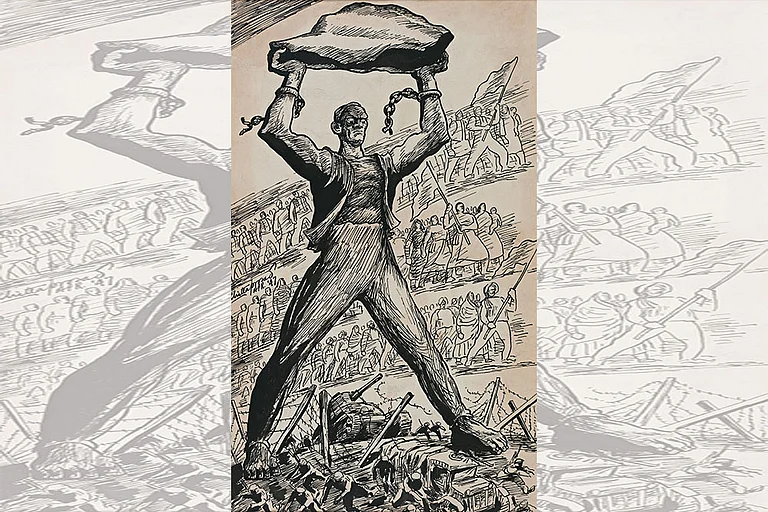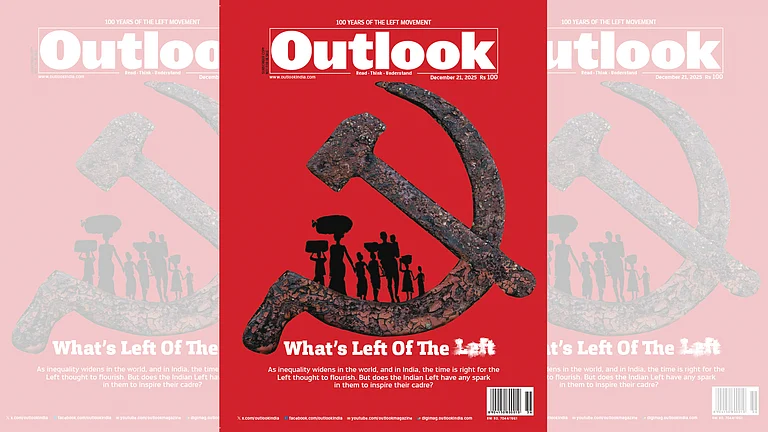This story was published as part of Outlook Magazine's 'Cow Prescription' issue, dated February 6, 2023. To read more stories from the issue, click here.
Imagine, in an undertaking like the ‘Bharat Jodo Yatra,’ a school child is taken from Kanyakumari to Kashmir. Which animal would he/she see more in number and find more useful to human life: the buffalo or the cow? If the quantity of milk that restores our health and well-being were the standard by which one judged the use value of an animal, which animal produces more milk in India, not just now but historically: the buffalo or the cow? According to a report on Statista, an online provider of market and consumer data, “Indigenous non-descriptive buffaloes had the highest share of milk production in India with 45 percent in the fiscal year of 2021.” In Indian agrarian history, the male buffalo was used in more regions than the bull (male cow) to till the land and pull carts. In any Indian village, among the poor, the buffalo is seen as a source of livelihood that would make a marriage alliance acceptable. The buffalo, in the absence of landed property and guaranteed wage earning, is seen as the main source of livelihood. In Telugu, the proverb “Barre lenide batuku ledu” (No buffalo, no life) should convey the historical use value of the buffalo.
On the other hand, make a child read ancient Indian literature in Sanskrit from the Vedas to the Ramayana, Mahabharata, Bhagavatas and so on. Which animal is mentioned more times, and discussed at length in such literature: the buffalo or the cow? Or read the literature produced in any regional language or in Indian English texts; which animal is given more place in discourse? In most literary sources, the cow was and is praised as Kamadhenu (a celestial cow whose milk is life itself), Gomata (Mother Cow) and as the mother of gods and goddesses. Paintings with divine figures of the Hindu pantheon sitting in the stomach of cows are aplenty. It is these kinds of literary narratives around cows that led to the formation of the idea of the Hindi-speaking region being referred to as the ‘cow belt’ of the country. In Sanskrit literature, the male buffalo finds a place, at best, as the vahana (vehicle) of Yama, the god who escorts humans to naraka (hell). At worst, the poor animal is condemned as the demon, Mahisha.
If the Sanskrit books of ancient times and modern books in English and regional languages were the only sources of our knowledge of the animals that once existed in India, the buffalo would seem non-existent. Even in the few places that it is mentioned, it is cast as a ‘bad’ animal that should not be treated with love, for it is an agent of hell. The cow, on the other hand, is an animal that is frequently referenced, is more respectable and must be cared for.
This kind of partial treatment in favour of cows appears not only in what is now commonly known as ancient (and modern) Hindu literature but also in Islamic civilisations and in the Quran, according to which, Allah (God) approves of cows as fit for consumption. But nowhere in the Quran does the buffalo feature as a milk-producing animal or as an animal preferred for its meat. Nor are male buffaloes used as a source of labour in the Middle East. It does not exist in Europe or the Americas as a civilisational, cultural or economic symbol. But cows exist in all those countries, both as milk-producing and meat-supplying animals. When cows are so common in the world but buffalo are not, why do cows get such special treatment in Indian literature, Hindu ideology and politics? Why does the cow get treated as ‘divine’ at the cost of the reputation of the buffalo—an animal endemic to the region which also has enormous economic value?
Naturally, one would wonder at what stages in our civilisation were the buffalo and the cow domesticated. We do not have the dates or a timeline. Both species were found aplenty in ancient times. The buffalo was not ‘brought in by colonial rulers’ for it to be to be considered with disrespect. It existed in Vedic times and certainly in pre-Vedic Harappan civilisation. Why, then, has the buffalo become demonic, and the cow, divine?
The answer may be found in Brahminical philosophy that dominates religious and cultural discourse in India. As I mention in the book, From a Shepherd Boy to an Intellectual: My Memoirs:
‘Caste is Race in Ancient Times
Race is caste in Modern Times’
Even though the black-coloured buffalo gives white-coloured milk, it was cast as a demonic creature in Sanskrit literature, and continues to play that role in the cultural domain. This is the contribution of the Brahmins to the spiritual, social and cultural history of India. Why? Because it is a black-coloured animal. The place of the buffalo in Brahminical literature is exactly like that of the Shudras and Dalits in Sanskrit literature. Like the buffalo, they too are given no space to generate discourse and find no mention within it, even though they comprise a considerable fraction of the social mass who produce food and cultivate other resources in this country.
This cultural conflict of the place of the buffalo versus that of the cow is rooted in Brahminical politics of colour, where black is considered demonic and white suggests divinity.
The cow, which is broadly thought of as a white-coloured animal (though there are reddish-brown and black cows as well) has always been portrayed as divine, both in ancient and modern times. Like in Islamic civilisations, beef was the preferred meat presented as prasadam (ritual offering) for a long time in ancient and medieval India. Exactly along the lines of Islamic spirituality, the Brahmin rishis (sages) used cows and their products for food, milk, ghee and so on.
Why, then, is the cow seen as an ‘anti-Muslim’ animal? That is a mystery in terms of the conditioning of the consciousness of the Hindus. It is also a mystery in Indian nationalist theory. An animal consumed globally for its meat becomes a divine creature in Hinduism.
At what stage in Brahminism was the cow spiritually constructed as sacred but unsuitable for consumption? Was it part of the Brahmin-led transformation to vegetarianism seen in many parts, if not all parts, of India? One view is that the conflict between Buddhism—that opposed ritual animal sacrifice—and the Brahminical practice of the same led to the latter being forced to give up meat-based food completely, and recasting themselves as ‘pure’ vegetarian, like the Jains.
Neither colonialism nor modernity has changed the Brahminical construct of the cow being sacred and the buffalo being demonic. If the colour of the animal being the impetus behind this discrimination were indeed true, it does not explain why the hair on the head of Brahmin men and women is not seen as ugly or a bad omen! On the contrary, black hair on the head is seen as a symbol of beauty, both in real life and in literature.
The theory of the ‘holy’ cow is now ‘State theory’ after the Rashtriya Swayamsevak Sangh (RSS)-backed BJP came to power in 2014. Nobody is allowed to eat cow meat, but one can eat buffalo meat as much as one wanted to and export it as well. The taste of buffalo meat does not find a mention in any cookbook, although writing about it does not send the writer to jail. The taste of cow meat is universally written about. In India, it is part of secret cookbooks.
Although most Indian children grow up on buffalo milk, there is not much research on it. On the contrary, there is enormous Hindutva-backed research about the medicinal values of cow milk, urine and dung. But no research is done on buffalo urine and dung and how they differ in composition and possible uses. The spiritual perception of something gets to be examined in the scientific domain only in India where charlatans such as Baba Ramdev can become scientists.
How does the cow politics of the RSS/BJP or relevant theories by scholars justify the complete marginalisation of the buffalo in our history, memory, consciousness and culture? When a ruling party like the RSS/BJP aggressively campaigns for cow protection without considering the buffalo as a historic national animal, would that not reinforce the caste and racial colour discrimination even further? The very same school of Hindutva continues to claim that India will advance in science and technology to a level where it shall overtake Europe, the US and China in the next few decades. That India will be Vishvaguru (‘Teacher to the world’) in the next few decades.
But for me, as a person who grew up as a shepherd boy, God created all animals as equal to all the humans that were and are created. If North India continues to be treated as the cow belt, a day will come when South India will become a buffalo belt.
The only solution is that no region gets to control discourse about any one animal so that India remains one nation with respect for all humans, animals, colours, castes, religions and races, with women on par with the country’s men.
(This appeared in the print edition as "The DEMONIC and the DIVINE")
(Views expressed are personal)
Kancha Ilaiah Shepherd is a political theorist, social activist and writer





















